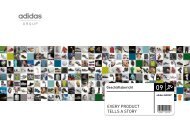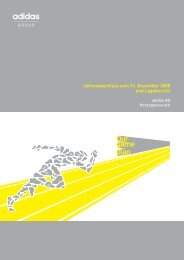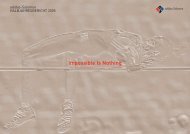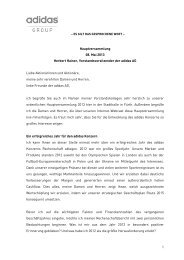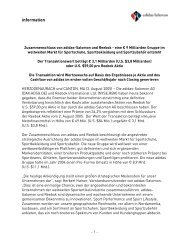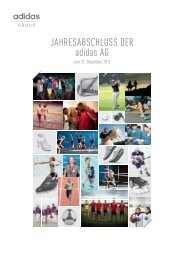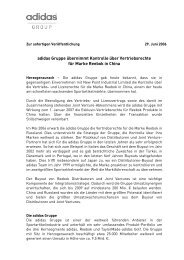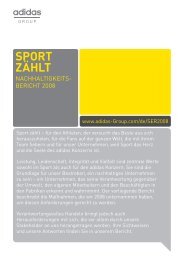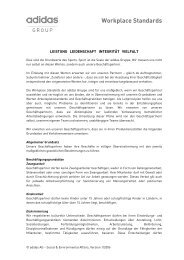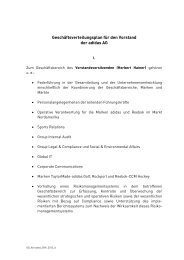Environment PDF - adidas Group
Environment PDF - adidas Group
Environment PDF - adidas Group
Create successful ePaper yourself
Turn your PDF publications into a flip-book with our unique Google optimized e-Paper software.
This is where the team will explore if the component can<br />
be thinner: using less material means less waste and less<br />
embedded carbon. It also helps meet cost criteria. The<br />
choice of materials is key, too. If the component can be made<br />
from a lighter material then that will also reduce carbon<br />
emissions. And with plastics being oil-based, the team is<br />
also on the lookout for bio-based alternatives.<br />
Robert says: “If we get the lightweighting right, this generally<br />
improves performance as well because it makes the final<br />
product faster and more comfortable to use. But whatever<br />
we put in, it has to be right. If the performance is not there<br />
we won’t use it.”<br />
Improving product performance is key and it seems that the<br />
processes and tools in place to achieve this lend themselves<br />
to improving environmental performance, too.<br />
fORmOTION TeCHNOLOgY<br />
An example of where new technologies have been used to<br />
improve performance and reduce environmental impacts<br />
is in the fORmOTION heel component for footwear.<br />
fORmOTION is a free-moving heel system that is<br />
decoupled from the sole which allows a pair of trainers to<br />
adapt to each individual’s running style to give a smoother<br />
running experience.<br />
“Sometimes our learning can come from another industry,”<br />
says Robert Leimer. “The hot runner technology we use for<br />
some of our fORmOTION heel components has been widely<br />
used in other areas like the automotive sector.”<br />
The hot runners used in fORmOTION reduce waste by<br />
eliminating sprue units. The sprue is the passage through<br />
which melted plastic is injected. during the injection process<br />
the melt hardens in the sprue which means it needs to<br />
be removed from the finished product and thrown away.<br />
eliminating sprues thanks to the use of hot runners has<br />
reduced material waste by up to 50%.<br />
A modular mould system which allows for the same mould<br />
base to be used on different products also reduces waste.<br />
And using lighter, stiffer materials means less material is<br />
used and also cuts down on carbon emissions because the<br />
finished product is lighter to transport.<br />
finally, for our current development, the amount of glue used<br />
has been reduced by using laser welding or a mechanical<br />
locking design, thereby reducing emissions. And where glue<br />
is used, the team has specified water-based glues as much<br />
as possible.<br />
fORmOTION eNVIRONmeNTAL BeNefITS<br />
• Using hot runners means up to 50% less material waste<br />
• Less glue so fewer toxic emissions<br />
• Lightweight construction technologies reduces material<br />
use and CO emissions from transport<br />
2<br />
• modular mould system allows for sharing mould bases<br />
between products and so reduces mould material waste.<br />
DESIGN<br />
01 ABOUT OUR pROgRAmme<br />
17 eNVIRONmeNT<br />
41 SUppLIeRS<br />
57 empLOYeeS<br />
64 COmmUNITY<br />
72 peRfORmANCe<br />
102 gRI INdex<br />
Here James Carnes, Vice president design for <strong>adidas</strong> Sports<br />
performance explains how his team is responding to the<br />
environmental agenda.<br />
Q: What are the key challenges for you in the design team<br />
in ‘going green’?<br />
A: The key challenge is to find a way to go from recognising<br />
the importance of the topic to actionable ways of working.<br />
Targets are important but you need cultural change as well.<br />
You need to spread awareness so that people want to do it<br />
because it feels right, not just because they are being told to<br />
do it.<br />
So the most obvious area for us to look at is our use of<br />
colours. We went through the numbers with the team, and<br />
there was no commercial reason to have 800 colours in use<br />
at any one time. We calculated we could use half that many.<br />
So that is now our target.<br />
We showed our designers some photos of what happened in a<br />
factory when we made a decision to change from one orange<br />
to a slightly different orange. We all saw how much water,<br />
chemicals and materials were wasted. Now our designers<br />
have a connection with what it means to change a colour.<br />
They are emotionally empowered to achieve the 50% target.<br />
Q: Is pursuing environmental goals a constraint to your<br />
team’s creativity?<br />
A: We asked ourselves the question: “Are we risking our<br />
ability to provide variety by reducing colour?” Our entire<br />
design directors’ team said ‘No’. We are increasing our ability<br />
to be a brand that has impact and sets trends by making bold<br />
decisions to be narrower in our focus.<br />
designers have a natural instinct to simplify. “How do I reduce<br />
this down to what I need to make a statement?” If you make<br />
sustainability a factor that they use to simplify, they get used<br />
to it.<br />
Q: So environmental considerations can be an opportunity<br />
for you?<br />
A: Yes, it starts to become one of the greatest opportunities<br />
for designers. Now they identify early on that there is an<br />
opportunity to steer a product to being high performance<br />
and also made in a sustainable way. In the past, it was a<br />
compromise to make something sustainable. Now the two<br />
things are striking a chord.<br />
So for example, in footwear, we have a designer who was<br />
working on improving the process of making a line of trainers.<br />
He investigated simplifying the construction into only three<br />
separate components: the upper and cushioning system in<br />
one piece, the traction and then the tongue and laces. So<br />
that makes the product itself even more high-tech and high<br />
performance. But the ability to make the product without<br />
significant labour means it can be made in germany or the<br />
USA. So you have less shipping and a smaller carbon footprint.<br />
The VIK fluid Trainer is the shoe we will give to the Olympic<br />
volunteers. It has achieved the highest level under Better<br />
place and what we have done is to re-engineer the whole<br />
process so there is no cement holding the pieces together – it<br />
IN THE REAL WORLD PERFORMANCE COUNTS Sustainability Report 2010<br />
24



